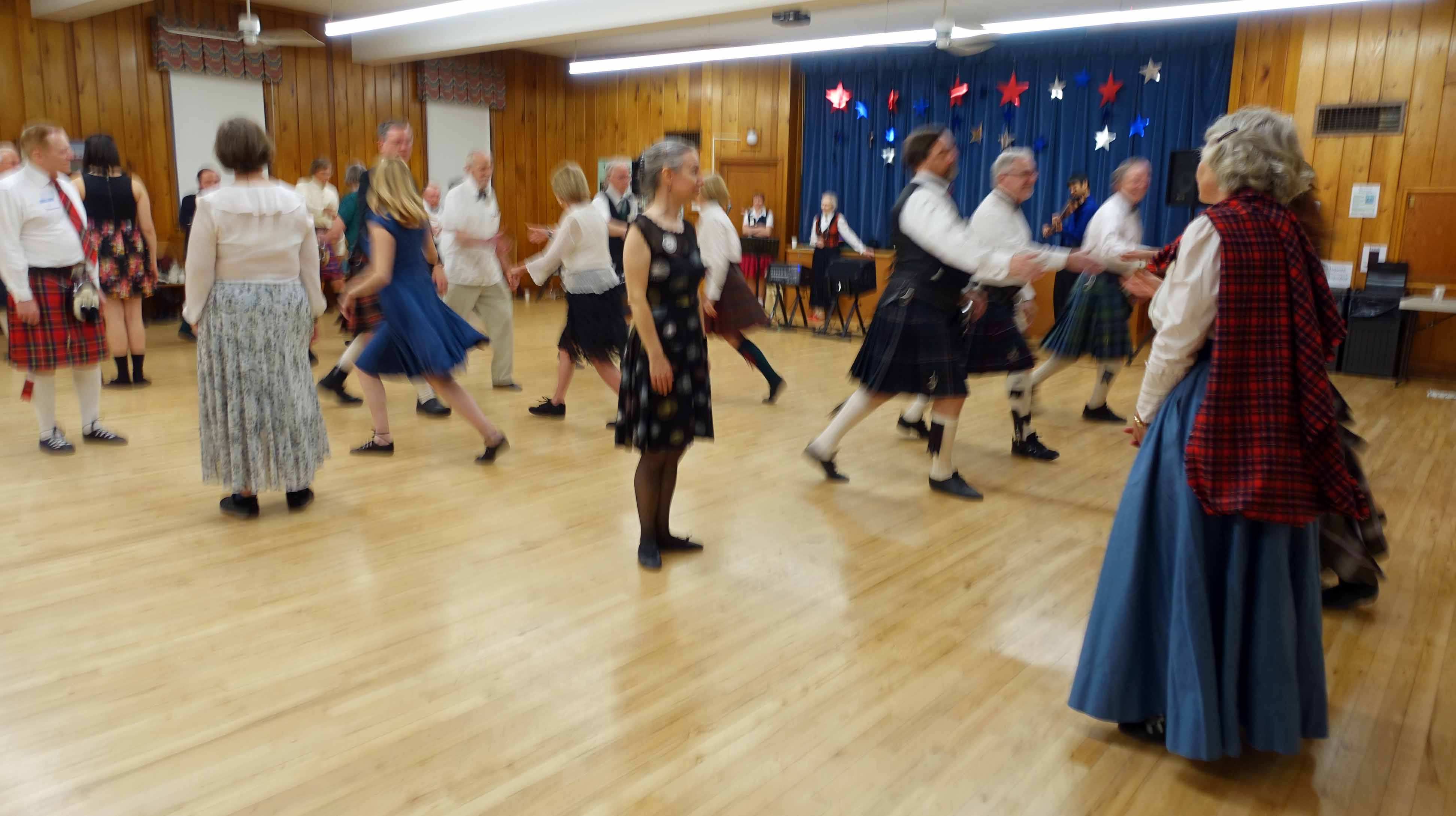
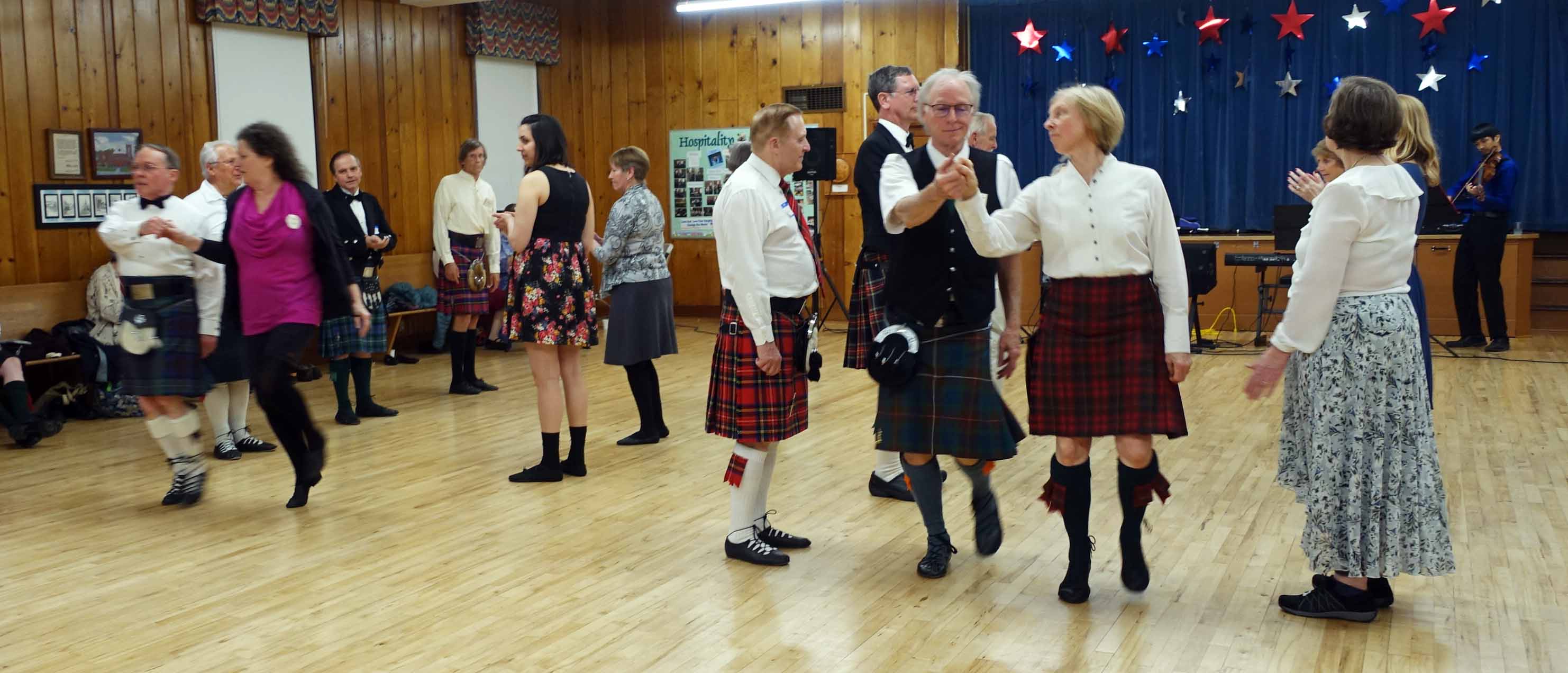
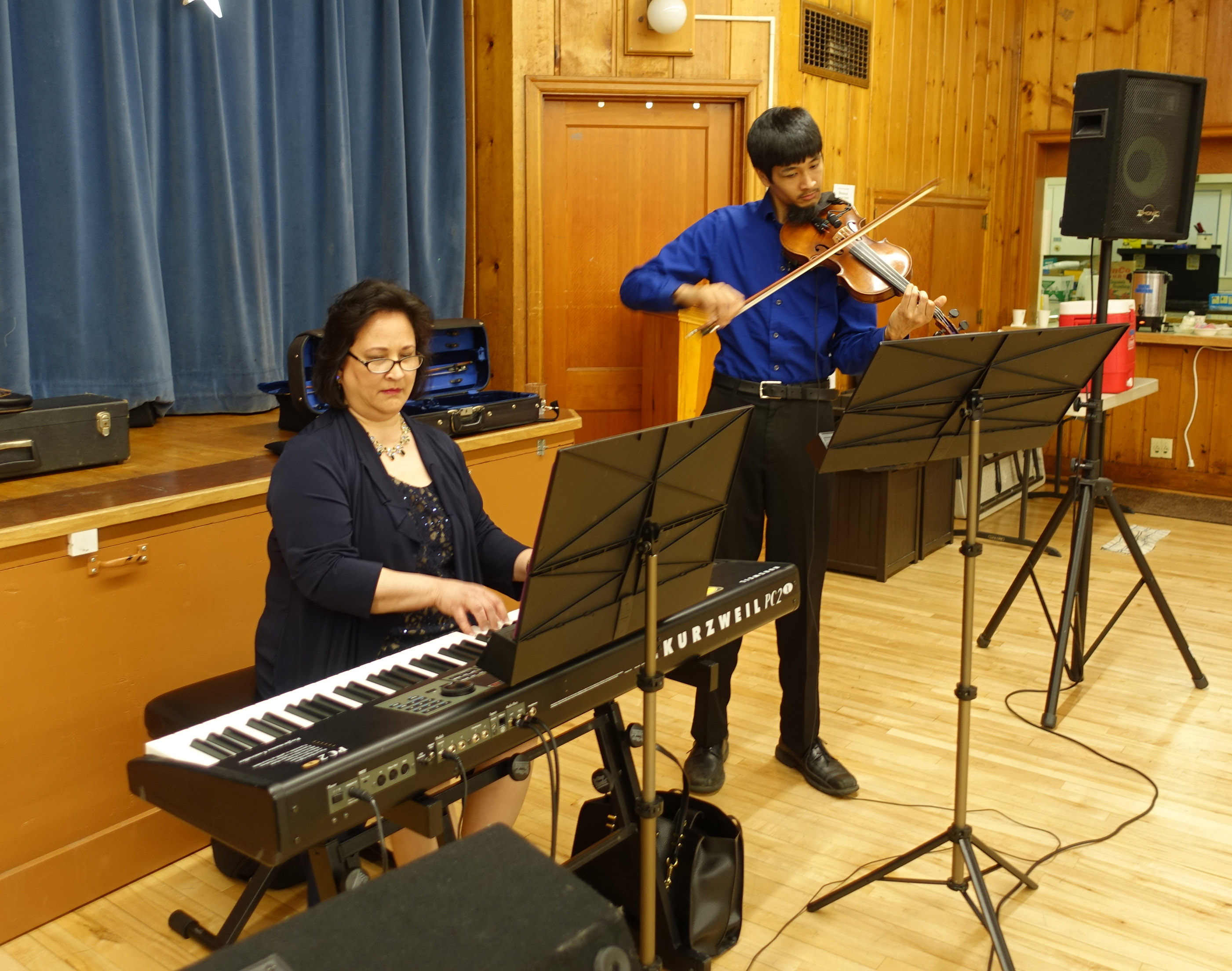
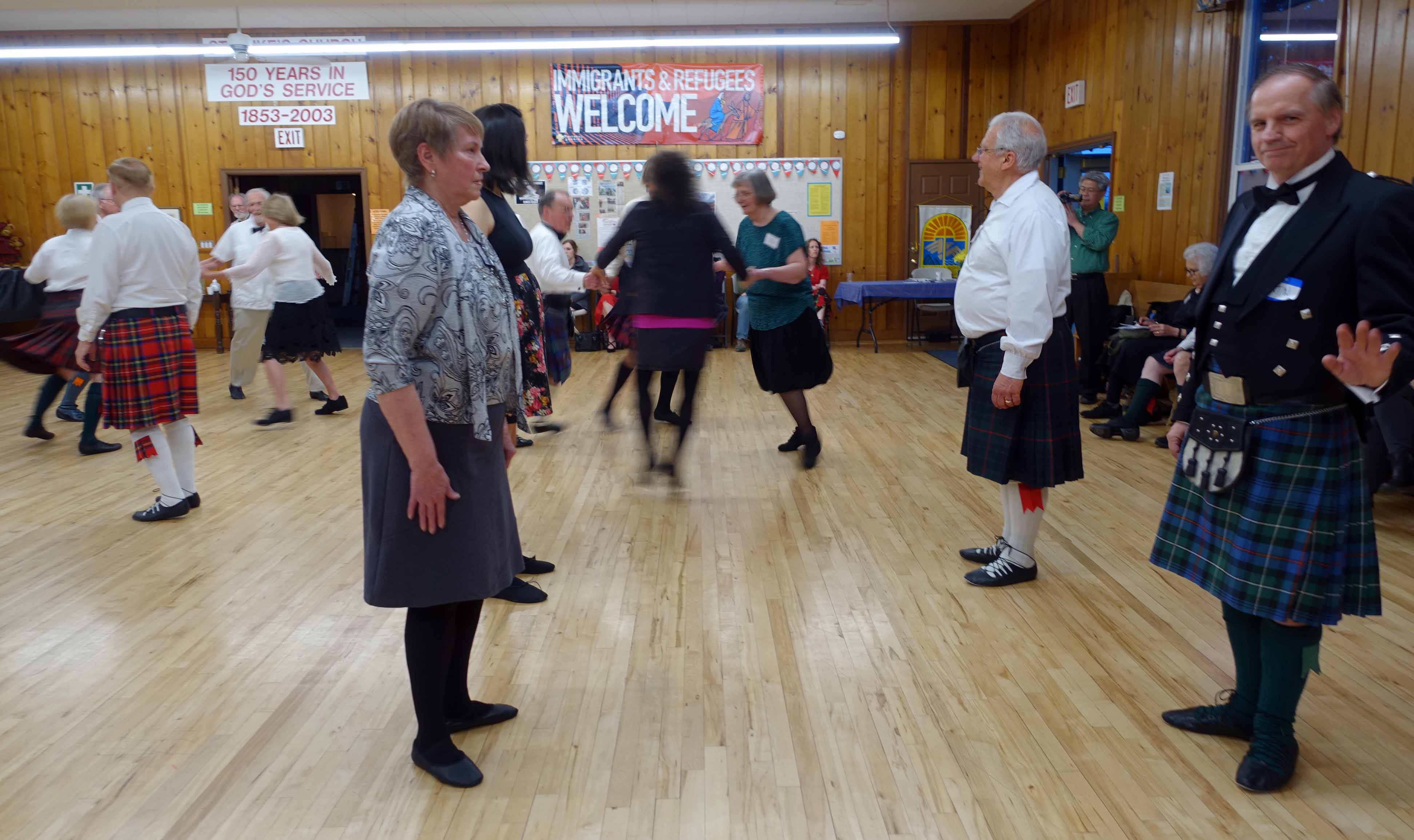
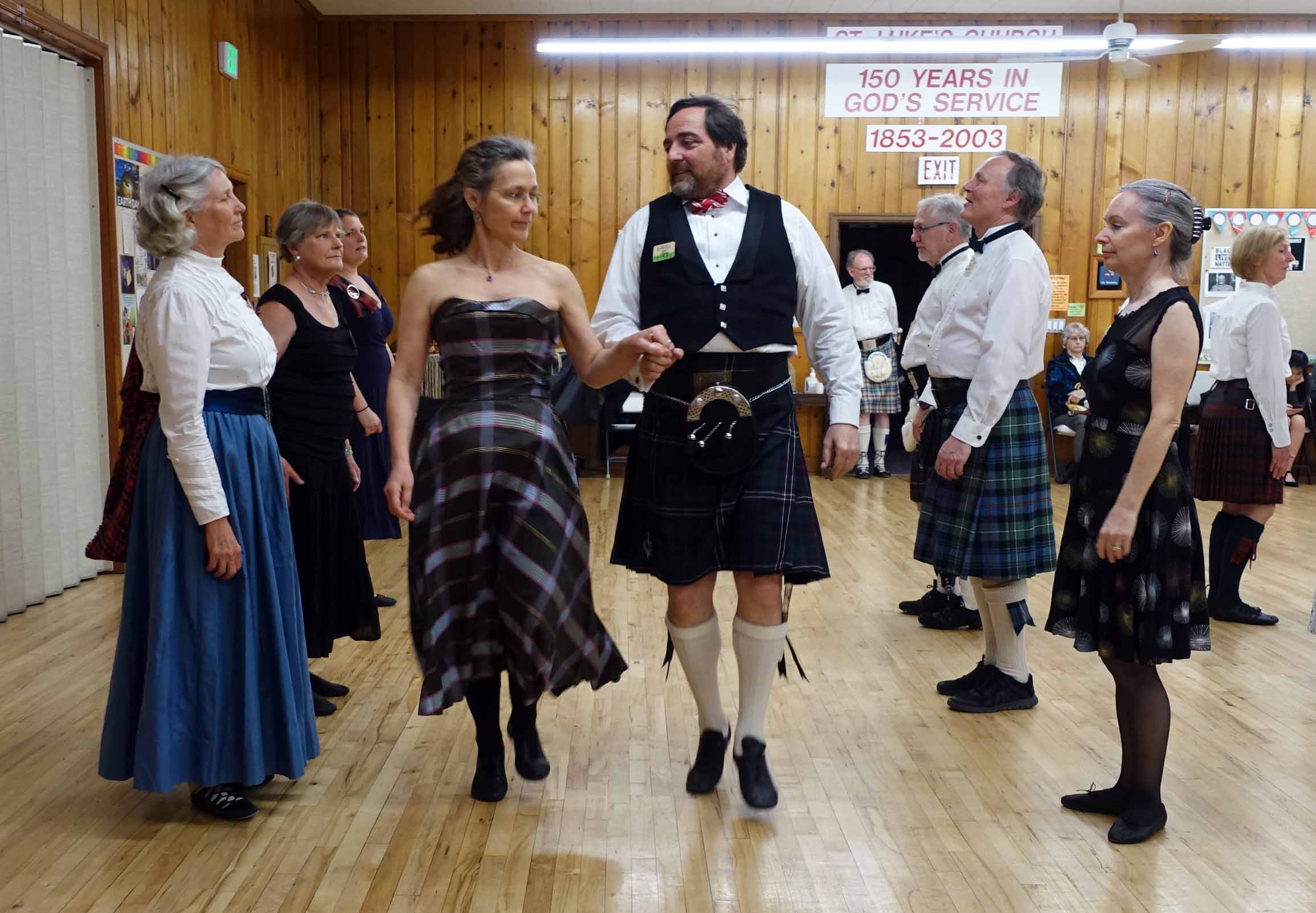
| Volume 34 #6 | May/June 2018 | |
Here are the top ten trending dances worldwide from the DancieMaetion YouTube channel. Observe our very own Liza Halpenny's dance "Fair Enough" holds top spot currently. If you've not used this service put together by Linda Mae and Patrick, navigate to https://www.youtube.com/channel/UChpyMs9H00nfuzMbVLRcTIA ~ The Editor ~

Note, the ‘Archive’ dances are statistical holdouts from the DancieMaetion 1.0 videos. It will take some time, but eventually they will fade away.
Brigadoon! Ahh! What a fine place, indeed. Linda Lindley carried us all to the enchanted land o' Brigadoon! Such finery, such food provided by Harvest Moon, such music, such fine people. All in one fine evening! Pipers to spur us on, Sydney Thomson & Patrick Hogan, the lovely harpist Jennifer Pratt-Walters, pianist Cynthia Soohoo and fiddler Nathaniel Soohoo-Hui playing fine old tunes stirring up our dancing moves! To think, it all happened one magical evening, not so long ago and not to be forgotten!

|

|

|

|

|
Summarized by Melissa Whitson from the book Curious Scotland by George Rosie; with her apologies to any Presbyterians!
In Scotland, for centuries Presbyterians did not sing hymns as these were seen as quasi-secular in nature. Only the words of the Bible itself were deemed to be sufficient. As a result, in Presbyterian churches, a practice arose of using metric versions of the Psalms of David set to music and sung by choirs and churchgoers. However, because the words of the psalms were drawn from the Bible, they were regarded as sacred and only to be used in divine services, never in choir rehearsals. This meant that words had to be invented for whatever psalm tune was being rehearsed by a choir.
This led to the development of “practice verses,” particularly in the late 1700’s and early 1800’s. The resultant practice verses ranged from the bland and pious to the jaunty and satirical. Sometimes the practice verses incorporated the name of the tune, as in this example:
The name o’ this tune is called York,
The reason I don’t know;
They micht as weel have called it Cork,
Carmarthen or Raphoe.
Some of the practice verses had a satirical element, including this one which was directed at the minister himself:
Keep silence, all ye sons of men,
And hear with reverence due;
The minister he’s gane oot tae smoke,
But he’ll be back the noo.
For many years, every psalm was sung to one of only twelve tunes. New melodies were not welcomed by traditionalists in the church. There is a story of an incident at a church at the Bridge of Teith near Sterling; when the man who led the singing used a new tune, the minister was so appalled that he knocked the fellow unconscious with the pulpit Bible!
Some tunes in particular apparently lent themselves to a number of irreverent words, for example:
O mither dear, Tod Lowrie’s lum 1
Whan sweepit will it be?
For a’ the soot’s come tummlin’ doon,
An’ spilet ma grannie’s tea.
I wish I were a brewer’s horse
Yoked tae a cairt o’yill, 2
And that my heid was at my tail,
Then I could drink my fill.
1 lum = chimney
2 yill = ale
From the editor: It was common practice in those days to disallow music created by musical instruments as they were considered devilish in origin. The Gàidhlig singing dance music form
of puirt à beul had its roots in part from this time. Here is an autobiographical quote from the Victorian author George MacDonald from his novel "Robert Falconer" describing an event in his life that was quite
common in the Highlands of Scotland.
"Robert came home to dinner the next day a few minutes before Shargar. As he entered his grandmother's parlour, a strange odour greeted his sense. A moment more, and he stood rooted with horror, and his hair began to rise on his head. His violin lay
on its back on the fire, and a yellow tongue of flame was licking the red lips of a hole in its belly. All its strings were shrivelled up save one, which burst as he gazed. And beside, stern as a Druidess, sat
his grandmother in her chair, feeding her eyes with grim satisfaction on the detestable sacrifice. At length the rigidity of Robert's whole being relaxed in an involuntary howl like that of a wild beast, and he turned
and rushed from the house in a helpless agony of horror. Where he was going he knew not, only a blind instinct of modesty drove him to hide his passion from the eyes of men. "
Traditionally, for time immemorial, at least for me, the Southwest Washington State Branch of the RSCDS has hosted a “Betwixt & Between” event. Members enjoy this opportunity around New Years Eve to dance and share their creative vices—er, abilities—with fellow dancers in this American style Ceilidh.
Some have shared their sense of humor, vocal or instrumental talents, favorite poems (either read or recited), enacted customized stories, to name a few examples of the fun to be had.
This last December 30, 2018, I found myself the recipient of the fruit of friendship, compassion and camaraderie in one of the ceilidh acts. Unbeknownst to me, one of the members, Mel Whitson, had commissioned Holly Gibson, another member, to devise a dance in my honor. She also rounded up enough dancers to perform it! I was both amused and moved at hearing the title Lady MacKenzie of Clackamas.
Many thanks to Mel Whitson, Holly Gibson, Ken Heinemann, Liza Halpenny, Tom Halpenny, Susan Shaw, Tom Shaw, Linda Mae Dennis, Akana Ma, Sydney Thomson and Martin MacKenzie for your implementation and expression of friendship at this recent event and over the years!
Enjoy the performance of this here:https://www.youtube.com/watch?v=mTc-NuHYlfE
The presentation of the printed and framed brief:https://www.youtube.com/watch?v=mU31pR1INhA
~ The Editor ~
We, Linda Mae Dennis (me) and Patrick Hogan (my husband), started making Danciemaetion movies in 2008. As a relatively new, fully-certificated Scottish Country Dance teacher, I wanted to do something that I thought would help the Society. As a relatively new dancer, Patrick wanted that ‘something’ to be of assistance to new dancers, and to him in particular. A ‘something’ that would explain and show the dances so that he could study on his own and not make embarrassing mistakes on the dance floor. In addition, one of the more experienced teachers in the area suggested that perhaps I should publish a book of my dances, since I seemed to have a penchant for writing them.
Patrick’s programming background and the work he had been doing with 3D animation, and my background in graphic arts led us directly to Danciemaetion. A quick Google search told us that Danciemation, without the ‘e’, was already taken, but it seemed a perfect name. Since I had decided that I would name my new book of dances “Mae I have this Dance?” – a play on my name, Linda Mae – we decided Danciemaetion, with the ‘e’, would be our thing instead. Now, at least on my computer, if I search on danciemation, without the added ‘e’, Google gives me results for danciemaetion as well – it’s rather gratifying.)
Patrick set to work on the program, and within a few days and a good deal of input from me, we had a working model. I insisted that women should be square and men should be round because that’s the way they are in 2D in the books. I also wanted the different couples to be different colors, so that they would be easy to identify during the dance – I have watched many videos where everyone is dressed the same and it is far too easy to lose track of first couple. The places were identified by color as well, so that it would be easy to see where each couple ended up, relative to their original place. This was to be about the dance patterns, the geography, so there would be no feet.
Each bar was divided into four parts, and each step was entered by hand on X and Y coordinates, along with a numeric angle so the ‘people’ would be facing the correct direction. I had charts and graphs, and little drawings of where to place the ‘people’ – first couple is turning one and five eights round, so where are they halfway through that??? We added a Z axis so that they could hop. And we had to record the voice-overs in the appropriate number of seconds – good thing Patrick is also a musician and has lots of sound equipment – match them up with a ‘click’ track, and make them into movies. None of this was trivial, and the development of the process took a long time.
After that long initial ramp up, the first eight Danciemaetions were published on a CD and came with the book “Mae I have this Dance?” They were fairly primitive, but got the ideas across. The next group of dances was for one of our local dances. It was taking much of my time to get each of the dances completed, so we made some improvements. We made a “library” program where I could store individual figures separate from a “dances” program that could import figures from the library and simultaneously assign roles to the dancers. For example, if rights and lefts occurs at the beginning of a dance, 1st couple is in 1st place, but if it occurs at the end of a dance we can tell the computer to change the roles of 1st and 2nd couples. Over the summer of 2009, I stocked the library with all the figures from The Manual. This was a good start, but of course, was inadequate because every dance devisor wants to do something a little different. For example, reels of three can be left shoulder, right shoulder, tandem, across, on the sides, 6-bar, 8-bar, blah, blah, blah. I currently have 44 different kinds of reels of three in the library, and still almost always have to adapt them to the dance I’m working on. Still, it was an improvement. Patrick then programmed the computer to interpolate between places, so I could tell it where the ‘people’ started and where they ended, and the computer could calculate where they would be between those points – only on straight lines, however. After a certain amount of whining, he added the ability for the computer to interpolate curves, which greatly improved the look of the reels and circles. Eventually, Patrick made it so that I could use the arrow buttons to move the ‘people’ around, so I could visualize approximately where I wanted them and then move them into place.
In the meantime, we were getting a little feedback from early adopters. The ‘click’ track was too loud, so we made it softer, and redid all the movies. We heard from dancers in South Africa that the movies were too big to download, so we made smaller movies and loaded them into a YouTube channel. We heard about other things, too, that we couldn’t do much about at the beginning – it was hard to tell the men from the women until you caught on that the women are square, it was hard to tell which was the front, and they didn’t have elbows. Most of the feedback was positive, though, which spurred us on.
Aside from our own web site ( http://danciemaetion.imaginationprocessing.com/DM2.php ), and our YouTube channel ( https://www.youtube.com/user/ImagProc/videos ), we picked up some wonderful champions on the internet. Both the Scottish Country Dance Database and the Scottish Country Dance Dictionary have made it a point to link to all of our videos. Both these sites are fantastic resources for Scottish Country Dancers, and we were so delighted when they welcomed our contributions.
I continued to animate Scottish Country dances, while Patrick went to work on the mobile app. Yes, there is a mobile app! It’s for Android only, and it is free. You just go to Google Play and download it – be sure to spell it with the ‘e’. The best thing about it is you can pre-download the dances you want for a particular occasion, and have them at your fingertips to review just before the dance. We have also used the mobile app to learn/review dances with groups of dancers – we cast it to the big screen, watched the Danciemaetion, discussed it briefly if there were questions, and then danced the dance. Could it be used for a Ball Review? I think so.
The popularity of our videos has continued to grow, with an average increase in views of about 10% each year – over 328,000 views overall in the past nine years, with about 83,000 views in 2017. A disproportionate number of men watch these videos – we speculate that men may be more sensitive to feeling a fool on the dance floor than women. Dancers in the UK account for 41% of all the views, dancers in Canada 14%, dancers in the USA, also 14%, and dancers in Japan 11%. The other 20% of viewers are from all over the world.
There are currently 386 completed dances in our list of videos. How do I decide which dances to animate? Well, I started off by animating all the dances for the major dances in our area, which keeps me pretty
busy from September through June, as there are two active RSCDS Branches in our neck of the woods, with five major dances through the season. I usually animate all the dances from out of town programs that
Patrick will be attending. When I am invited to teach a workshop, there is usually an associated Ball, so I’ll animate the Ball program. During the summers, I try to complete as many of the dances on Campbell
Tyler’s lists of popular dances as possible.
( http://www.rscds-ib.org/index.php/campbelltaylerlists)
Campbell collects programs from all over the world, analyses them, and publishes lists of most popular dances. I have made Danciemaetions for most of the first hundred. ) And, of course, there’s money. If
you pay me, I’ll animate dances.
Last year, Patrick did a major upgrade of the program. The women still have square bottoms on their dresses but they’re now slimmer than the men, so it’s easier to tell them apart. Everyone has a nose now, so it’s easier to see which is the front. The dancers move more smoothly now, too, so there are fewer wait-what-just-happened moments. On the other hand, some of the underlying programming is different, which may have caused some strange behaviors. It would be beneficial to me if users would notify me if they notice any strangeness or outright mistakes. Just drop me a line – . One of the great things about animations is that they can be fixed quite handily and reposted. No need to get the dancers together again to film another video.
All of the old jerky videos will disappear before long, so if you come across a broken link, please let the web master know that they need to re-link to the new video in the Danciemaetion YouTube channel. The success of Danciemaetion has helped us feel much more connected to the world-wide Scottish Country Dance community, and we are so thankful for the many friends we’ve made (and never met). We hope to continue to create helpful animations for many more years so that new and experienced Scottish Country dancers can feel more confident on the dance floor.
Calendar of Events | ||||||||||||||||||||||||||||||||||||||||||||||||||||||||||||||||||||||||||||||||||||||||||||||
|
|